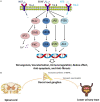Neurobiological insights into lower urinary tract dysfunction: evaluating the role of brain-derived neurotrophic factor
- PMID: 38148930
- PMCID: PMC10749380
Neurobiological insights into lower urinary tract dysfunction: evaluating the role of brain-derived neurotrophic factor
Abstract
Lower urinary tract dysfunction (LUTD) encompasses a range of debilitating conditions that affect both sexes and different age groups. Understanding the underlying neurobiological mechanisms contributing to LUTD has emerged as a critical avenue for the development of targeted therapeutic strategies. Brain-derived neurotrophic factor (BDNF), a prominent member of the neurotrophin family, has attracted attention due to its multiple roles in neural development, plasticity, and maintenance. This review examines the intricate interplay between neurobiological factors and LUTD, focusing on the central involvement of BDNF. The review emphasizes the bidirectional relationship between LUTD and BDNF and explores how LUTD-induced neural changes may affect BDNF dynamics and vice versa. Growth factor therapy and the combined administration of controlled release growth factors and stem cells are minimally invasive treatment strategies for neuromuscular injury. Among the many growth factors and cytokines, brain-derived neurotrophic factor (BDNF) plays a prominent role in neuromuscular repair. As an essential neurotrophin, BDNF is involved in the modulation of neuromuscular regeneration through tropomyosin receptor kinase B (TrkB). Increasing BDNF levels facilitates the regeneration of the external urethral sphincter and contributes to the regulation of bladder contraction. Treatments targeting the BDNF pathway and sustained release of BDNF may become novel treatment options for urinary incontinence and other forms of lower urinary tract dysfunction. This review discusses the applications of BDNF and the theoretical basis for its use in the treatment of lower urinary tract dysfunction, including urinary incontinence (UI), overactive bladder (OAB), and benign prostatic hyperplasia (BPH), and in the clinical diagnosis of bladder dysfunction.
Keywords: Brain-derived neurotrophic factor; benign prostatic hyperplasia; overactive bladder; pelvic muscle; pudendal nerve regeneration; sphincter function; urinary incontinence; voiding dysfunction.
AJCEU Copyright © 2023.
Conflict of interest statement
None.
Figures



References
-
- Kubiak CA, Grochmal J, Kung TA, Cederna PS, Midha R, Kemp SWP. Stem-cell-based therapies to enhance peripheral nerve regeneration. Muscle Nerve. 2020;61:449–59. - PubMed
Publication types
Grants and funding
LinkOut - more resources
Full Text Sources
Research Materials
